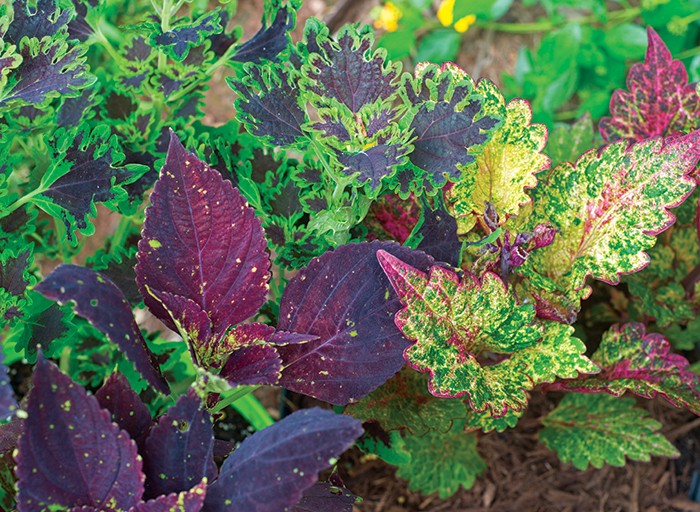Although flashy, many summer flowering annuals can be such fleeting things in an ornamental garden. That’s why it’s a good idea to have a Plan B for constant color. One of my go-to choices is coleus — well, a particular kind of coleus.
Since the 1800s, U.S. gardens have been treated with dainty, multi-colored coleuses that dwelled in semi-shaded sites and rarely ventured into the full summer sun. However, by the dawn of the 21st century, tougher, rougher, rowdier coleus forms were being developed by plant breeders. Collectively called “sun coleuses,” they tended to be bigger than many classic cultivars and, as a pleasant surprise, actually take on more sun.
Just about any color except blue — purple, salmon, chartreuse, orange, copper, bronze, pink, burgundy, yellow, scarlet — can be found in streaks, splashes, splotches and solid colorations on the flashy foliage of these sassy coleus cultivars. And if a wide range of colors is not enough, leaf forms and textures are also all over the map.
Depending on the cultivar, sun coleus selections can top out at 1 foot to almost 3 feet tall, and can be about as wide — if developing plants are tip-pruned once or twice to produce bushier specimens.
“Sun coleus” is the name given to these pretties, but “sun-tolerant” would be a better tag, because they ain’t cacti. While these coleuses will enjoy the morning sun, they could shrivel from Ol’ Sol’s strong summer rays from midday into the early afternoon. To help minimize the sun’s effects, water when the rains don’t come, mulch and plant in rich, well-worked, loamy soil. This last point is important in order to keep the growing ground evenly moist and not swampy, which could encourage root rot to come out and play. And because quality potting soil drains well, this also makes sun coleuses prime candidates to be container cuties.
Sun coleuses won’t be hard to find at local garden centers now, but, if you like being overwhelmed with choices, one of the largest assortments of cultivars I have found in this area is at Big Bloomers (bigbloomersflowerfarm.com), just a short drive down US 1 in Sanford. Also, check out Rosy Dawn Gardens (rosydawngardens.com) online. They have a ton of different selections for e-sale, but even if you don’t buy any from them, their website is an eye-opening tour of some of the many possibilities from the wide, wide, colorful world of sun coleuses!

Along with Persian shield (left) and Cuban oregano (right), this colorful coleus cutting is being easily rooted in water.
If you want to share your favorite sun coleus with a gardening friend, most can be easily rooted in water. Cut a 5- to 6-inch stem just below a leaf node, take off all but the top four to five leaves and place it outside in a bottle of water located in bright, indirect light. Roots should appear in a few weeks, which is when the new plant is ready to go into a container of premium potting soil. Since coleuses are tender and will be nailed by the first frosts of autumn, this simple rooting technique is also a good way to save living souvenirs from the current growing season and develop cuttings of your pretties indoors this winter for next spring’s garden.
To Do in the Garden
May
- The tip-pruning trick for bushier coleuses will also work well with such flowering annual favorites such as petunias, marigolds, cosmos, salvias and zinnias. Pinch their branch ends back to the next leaf node after the plants reach about six to eight inches tall to encourage early branching.
- Some summer-blooming plants remain in flower only if the spent blooms are picked off to make room for new ones. If you don’t have the time — or desire — to police your garden for pooped out blossoms, consider growing self-cleaning plants such as lantana, impatiens, calibrachoa, vinca, begonias, portulaca and euphorbia.
- Birds will be working overtime with spring activities this month, so give ’em a friendly hand by lightly wiping the birdbath and then refilling it with another round of refreshing water at least once a week.
June
- Keep filling up the veggie patch. This month, green beans, lima beans, tomatoes, pumpkins and sweet potatoes can be planted to round out the late spring edible garden.
- Grapefruits are supposed to make your mouth pucker, not cucumbers. Yet homegrown cukes can take on a bitter bite if developing plants are stressed by long rainless spells. For mild-tasting cucumbers, mulch around the plants and water once or twice weekly during extended dry times.
- Hive Mind
- Do the Hustle
- Takeout, Delivery & Crossed Fingers
- Liquid Assets: Smoothsicle from Funguys Brewing
- Smell, Seek, Find
- Pet Parade: Our Awesome Animals
- Small Business Spotlight: Woof Gang Bakery
- Nonprofit Spotlight: Best Friend Pet Adoption
- From the Editor: Fleeing from the Virus
- Garden Adventurer: The Constant Color of Sun Coleuses







